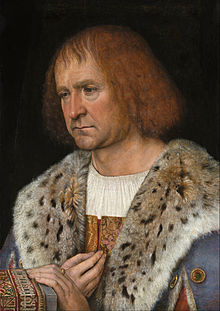Michael Sittow
| Michael Sittow | |
|---|---|

Diego de Guevara by Sittow, ca. 1517
|
|
| Born | 1468/69 Reval (now Tallinn, Estonia) |
| Died | 1525 Reval |
| Education | Hans Memling |
| Known for | Painting, Portraits |
| Movement | Early Netherlandish painting |
Michael Sittow (c. 1469 – 1525), also known as Master Michiel, Michel Sittow, Michiel, Miguel and many other variants, was a painter from Reval (now Tallinn, Estonia) who was trained in the tradition of Early Netherlandish painting. For most of his life, Sittow worked as a court portrait painter, for Isabella of Castille, the Habsburgs and others in Spain and the Netherlands. He was one of the most important Flemish painters of the era.
Michael Sittow was born in 1468 or 1469 in Reval to a wealthy family. His father was painter and wood-carver Clawes (Claves, Claes) van der Sittow (Suttow) and his mother was Margarethe Molner. He was the eldest of three brothers, followed by Clawes and Jasper.
The origins of Clawes van der Sittow (? - 1482) are not clear - he might have originated from the village of Zittow near Wismar or he could have been of Flemish origin. He arrived in Reval in 1454 and became a citizen in 1457. Clawes was a wealthy man for an artist, owning several houses in the city. He became an assessor in the artists' guild in 1479. Clawes van der Sittow married Margarethe Molner (? - 1501) in 1468. She was a Swedish-speaking Finn and the daughter of a wealthy merchant Olef Mölner (Olef Andersson Mölnare).
At first Michel Sittow studied painting and sculpture in his father's workshop, while attending the city school to learn Latin, arithmetic and singing. After his father's death in 1482, Michel continued his studies in Bruges from 1484 to 1488. It is thought that he worked as an apprentice in the leading Netherlandish workshop of Hans Memling.
Michel Sittow became an independent master between 1488 – 1491/92, although he did not become a master in the local Bruges guild. Working as a portrait painter, he travelled in southern Europe, as traits of French and Italian art became apparent in his work.
From 1492 Sittow worked in Toledo, Spain for Isabella of Castille as court painter. Isabella assembled academicians and painters from several countries to her court. Sittow became known as Melchior Alemán ("the German") in the court, although letters of Emperor Maximilian and Margaret of Austria speak also of a painter "Mychel Flamenco" ("Michael the Fleming"), who may have been Michael Sittow. Sittow was the highest-paid painter in the queen's court, receiving a salary of 50,000 maravedis a year (Juan de Flandes, the second highest paid artist, received 20,000 maravedis). Sittow collaborated with Juan de Flandes on the series of small panels of the lives of Christ and the Virgin for the queen.
...
Wikipedia
